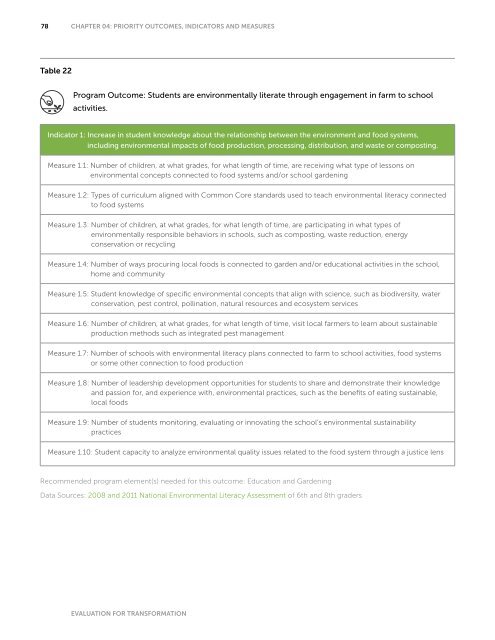Framework-08-25-14_web
Framework-08-25-14_web
Framework-08-25-14_web
You also want an ePaper? Increase the reach of your titles
YUMPU automatically turns print PDFs into web optimized ePapers that Google loves.
78 CHAPTER 04: PRIORITY OUTCOMES, INDICATORS AND MEASURESTable 22Program Outcome: Students are environmentally literate through engagement in farm to schoolactivities.Indicator 1: Increase in student knowledge about the relationship between the environment and food systems,including environmental impacts of food production, processing, distribution, and waste or composting.Measure 1.1: Number of children, at what grades, for what length of time, are receiving what type of lessons onenvironmental concepts connected to food systems and/or school gardeningMeasure 1.2: Types of curriculum aligned with Common Core standards used to teach environmental literacy connectedto food systemsMeasure 1.3: Number of children, at what grades, for what length of time, are participating in what types ofenvironmentally responsible behaviors in schools, such as composting, waste reduction, energyconservation or recyclingMeasure 1.4: Number of ways procuring local foods is connected to garden and/or educational activities in the school,home and communityMeasure 1.5: Student knowledge of specific environmental concepts that align with science, such as biodiversity, waterconservation, pest control, pollination, natural resources and ecosystem servicesMeasure 1.6: Number of children, at what grades, for what length of time, visit local farmers to learn about sustainableproduction methods such as integrated pest managementMeasure 1.7: Number of schools with environmental literacy plans connected to farm to school activities, food systemsor some other connection to food productionMeasure 1.8: Number of leadership development opportunities for students to share and demonstrate their knowledgeand passion for, and experience with, environmental practices, such as the benefits of eating sustainable,local foodsMeasure 1.9: Number of students monitoring, evaluating or innovating the school’s environmental sustainabilitypracticesMeasure 1.10: Student capacity to analyze environmental quality issues related to the food system through a justice lensRecommended program element(s) needed for this outcome: Education and GardeningData Sources: 20<strong>08</strong> and 2011 National Environmental Literacy Assessment of 6th and 8th gradersEVALUATION FOR TRANSFORMATION


